Norwich, England (Strutts News Services) – Since all of the raw data regarding climate change has been finally released to the public for scrutiny after many years of cooperation by the keepers of such proprietary knowledge and research, we at Tacky Raccoons believe it is our duty to present this data in a form that is easily understandable to all sentient beings.
(Click on any graph to enlarge it.)
This first graph illustrates the Vapors Constant. It reflects the ideal average temperature of the globe, without meandering from the mean average.
This graph shows the Vapors Constant, and adds the values purported by the Bieber-Naughton studies as well as the Moholy-Nagy data.
Here we retain the Vapors Constant while showing the results of Zager & Evans/Fooser-Bieber Conundrum. Note that they diverge.
Combining all four studies and retaining the Vapors Constant, results in the graph above.
Using the Strutts-Crumbler method, and overlaying the previous data sources, the results coagulate into a recobinizable pattern. This pattern can be simplified further.
Once the data are resolved and mushed around a bit, the patterns become intuitively obvious to the casual observer.
It’s the elusive “Hockey Puck” of global warming.
We’re doomed.
[Update 4 Dec 09: Additional related archived posts here.]

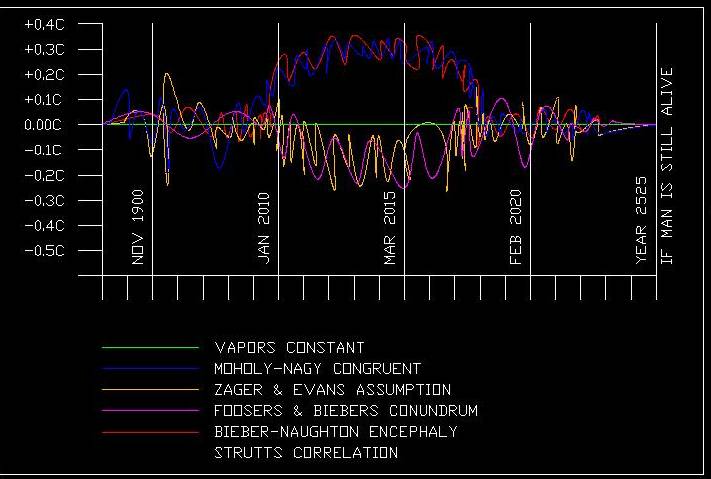
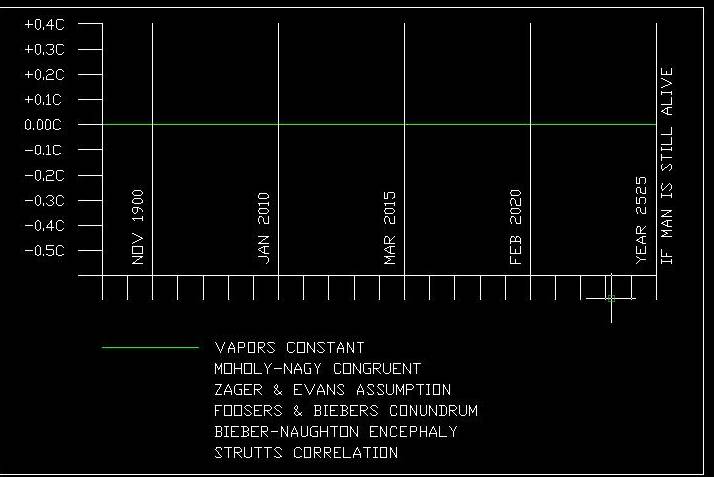

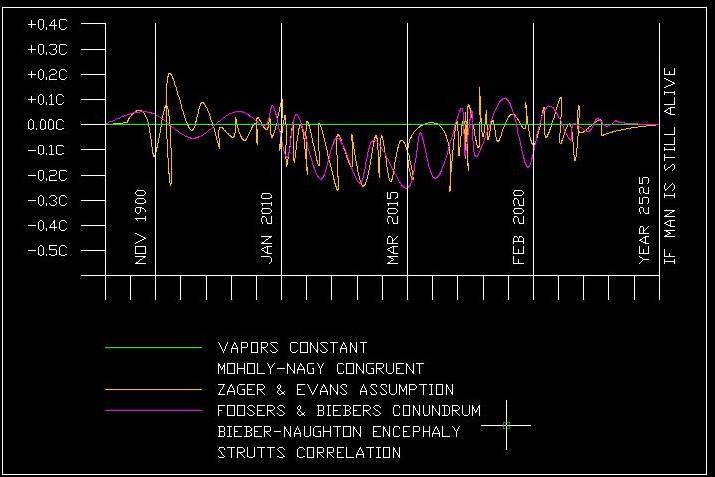
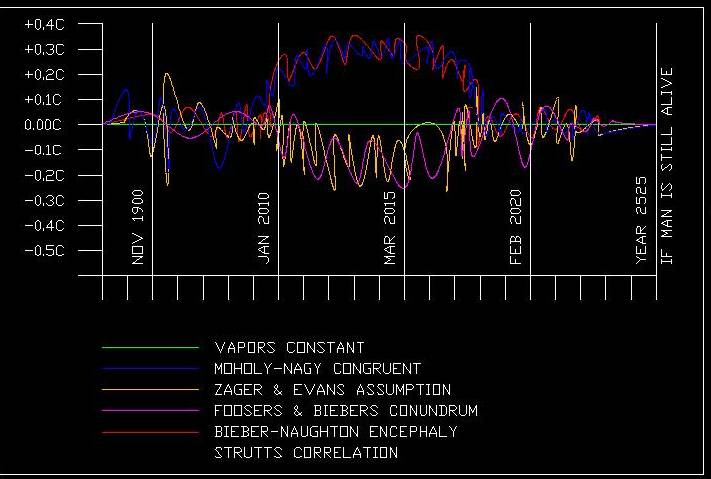
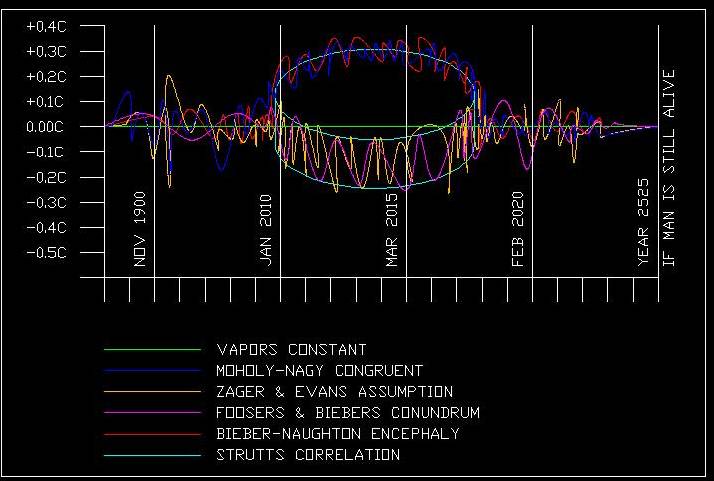
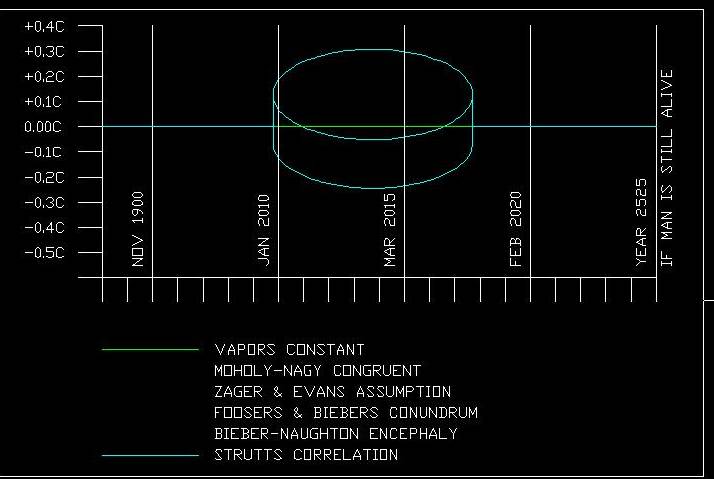
Zager & Evans? Hahahaha….. You slay me Bunksie!
LikeLike
nursem– Unfortunately most of the original records (including a 45rpm of Zager & Evans) were lost when we moved, so I had to resort to fuzzy memory.
LikeLike
I think you should to take into account the divergence patterns between Fooser’s and Bieber’s conundrum calculations, rather than aggregating them into an irrational function on the q axis. This will make the rotundulation of the apex more apparent.
LikeLike
Dr. Van W– Had you actually viewed the raw data you would have seen that we did indeed coalesce the mean of the minimum tolerances, resulting in the graphs that you see above. (The Ronstadt equilibrium quotient was blanketed for obvious reasons.)
LikeLike
ROFL — Love it!
LikeLike
Eric– 20th century Advanced Tublication is a lost art.
LikeLike
Moholy-Nagy Congruent has long been shown to affect only <45% of the atmospheric dynamics as measured by the CROOC in their 1911-1965 sample data at 85% confidence interval. This is elementary physics.
Ditto, Foosers & Biebers Conundrum. The Conundrum has recently been discredited in the reputable peer-reviewed journal Things Artificial. See, Muckers et al, 2008. For additional confirmation, see Crook et al 2009.
As for the Zager & Evans Assumption, well, this is where the danger lie for those who get involved in scientific fields outside their area of expertise and not being up to date with the literature. Just last week the famous Assumption was superceded by a new paradigm introduced by Professor Peter McDoguile and his collegue Dr. Hans Alotoffe of Patagonia State University, in a tentatively-named McDoguile-Alotoffe Paradigm.
So, it's back to the drawing board for you, boy!
LikeLike
sHx–Boy, if I had a dime for every time I heard that old saw.
Although the Moholy-Nagy Congruent fell into disfavor during the Carter Administration, most of the arguments were dismissed as being without merit during the Portensil Debates of 1987. You’ve surely heard of them. [Source: Schematics in Climatological Polycyanurism, Vol I, pp. 33-54. 1987, Cole University Press.]
Regarding the F&B Conundrum, critic Edmond Muckers was himself discredited and disbarred from climatology research in 1995 for fraud. If you recall, Muckers’ sole claim to fame was the infamous – and since disproven – CO2 “hammer.” Forced to team up with confederate Stuart L. Crooke (not “Crook” as you state) MC Environmental Analysis was awarded over $500,000 in research grants to study the non-existent MC Hammer hypothesis. Both are serving 5 year sentences for fraud, with a court order to pay back the missing grant money plus 20% penalty.
As for Z&E: I agree with you on this one with the caveat that not enough time has passed to answer the assumptions of the McDoguile-Alotoffe Paradigm.
However, after a brief review, I’ll offer this:
In its domain of definition, the time-p map of a scalar, autonomous holomorphic, complex differential equation, is itself holomorphic. This result is used by Sverdlove [1] when considering limit cycles in complex holomorphic differential equations. However no proof or reference for the result is given in [1]. Although this result must be well established, a proof does not appear to be readily accessible in the reference literature.
So, using the chain rule, what is:
frac{d}{dt}\left( \frac{1}{2} \left(\frac{d^2 x}{dt^2} \right)^2 \right) \,\,?
See where I’m going? Let’s set that one aside for a day or so.
(Sorry for the long-winded response, but you had it coming. 🙂
LikeLike
Ad hominem now, is it?
You wait! I have just submitted a What Are You Hiding request with the Office of Watts Up With That. As soon as I get the data released, I shall be able to rebut your arguments at length.
Meanwhile, ad, as they say, ios, am-bloody-igo! 🙂
LikeLike
That’s the best ClimateGate post I’ve read in 2 weeks. Genius.
LikeLike
sHx– No ad hominem attack at all. Just pointing out inadvertant fallacies in your assumptions. One more false accusation from you and I’ll see that your grant funding matches that of the Marionette Historical Preservation Society.
cbullitt– I’ve just transferred the funds from sHx’ MHPS-level account to yours. You owe me a Red Tail Ale. Or two. Keep the change.
LikeLike
Excellent. Very funny and a good representation of the current state of climate science.
LikeLike
Clima– Thanks for the kudos. Your check is in the mail.
LikeLike
Poppycock! By which I mean: I have caught an unmentionable (in polite company anyway) extremity in the pencil sharpener. Again. Were I not in such dire straits, I might have debunked this unadulterated mass of hog manure in short order.
But, seeing as how my dingle is in perilous dangle, I will merely say: you, sir, are no scientist. Now, to figure out how to remove myself, again, without needing to pick fleshy shavings from the grinding apparatus later.
LikeLike
Estar– Awash in the Sea of Hoss are we?
LikeLike